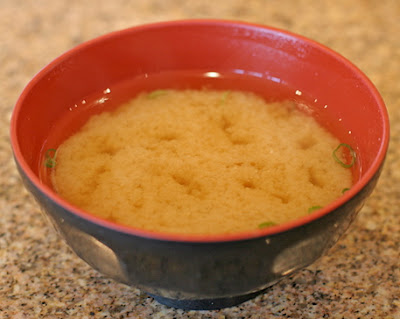Miso can range in color from white to brown.
The darker the coloring, the more robust the flavor and saltiness.
Hatcho miso (made from soybeans only)
Hatcho miso (八丁味噌)is a type of miso made in the Tokai region (now the 3 prefectures of Aichi, Mie and Gifu).
It was traditionally said to have been served to the emperor and is held in high regard.
It’s an all-soybean miso, which is about medium on the sweet/strength/saltiness scale, and is a good general purpose miso.
 | |
| hatcho miso |
Kome miso (made from white rice and soybeans)
Mugi miso (made from barley and soybeans)
 |
| mugi miso |
Genmai miso (made from brown rice and soybeans)
Natto miso (made from ginger and soybeans)
Regional Differences
Each region of Japan has its own type of miso according to the area's climate and eating customs. Shiromiso is a white miso made from rice native to Kyoto, hatchomiso, a sweet soybean miso particular to Aichi Prefecture, and Shinshu, the most widely eaten miso, is a salty, red-coloured paste, produced chiefly in Nagano Prefecture.
Major types of miso by color
Shiromiso (白みそ)or ‘white’ miso is the generic term for golden-yellow to medium brown miso.
It is milder than other kinds of miso, with a slight sweetness.
It’s the most versatile one for cooking purposes - you can use it for miso soups, miso marinades, and so on.
If you can only afford one kind of miso budget-wise or space-wise, get a good shiromiso that is labelled ‘medium sweet’.
Saikyo miso (西京味噌) is a golden yellow miso that was traditionally made in the Kyoto/Kansai region.
It is naturally sweet - the sweetness comes from the sugar produced as a byproduct of the fermentation process, similar to amazake (甘酒).
Makes a good dipping sauce or condiment, and is used as a sweet flavor in baked goods and so on by some Japanese vegan cooks.
Does not keep as well as other miso types since it’s lower in salt, so you must refrigerate it.
It’s very expensive!
Akamiso (赤みそ)or ‘red’ miso is the generic term for miso that is a dark reddish-brown in color. It is usually (but not always!) more salty and assertive in taste than shiromiso.
If you see a red-brown miso that is labelled a inakamiso (田舎味噌)or ‘country’ miso, you can be pretty sure that it will be strong in flavor and fairly salty.
Awasemiso (合わせ味噌)or ‘blended’ miso is just that, miso that combines two or more different types of miso together.
This is also a good general choice if you don’t want to assemble a miso collection.
Moromi miso (もろみ味噌)is a mildly salty, chunky miso, usually with added grains of rice or barley that is meant to be eaten as a condiment rather than in cooking.
It’s used rather like a dip on raw vegetables and things like that.
































